Tesco's Business Environment: Macroeconomic Impact and SWOT Analysis
VerifiedAdded on 2023/06/18
|11
|3125
|489
Report
AI Summary
This report provides an analysis of Tesco's business environment, focusing on the impact of macro factors and internal strengths and weaknesses. It begins by outlining the different types of organizations and the growth of the international business environment. The report then identifies the positive and negative impacts of the macro environment on Tesco's operations, using the PESTLE framework (Political, Economic, Social, Technological, Legal, and Environmental). It further discusses Tesco's internal strengths and weaknesses through a SWOT analysis, examining how these internal factors interrelate with external macro factors. The analysis covers aspects such as government policies, economic conditions, social trends, technological advancements, environmental regulations, and legal frameworks, highlighting their influence on Tesco's business decisions and performance. The report concludes by emphasizing the importance of understanding these interrelations for effective strategic management and achieving future goals.
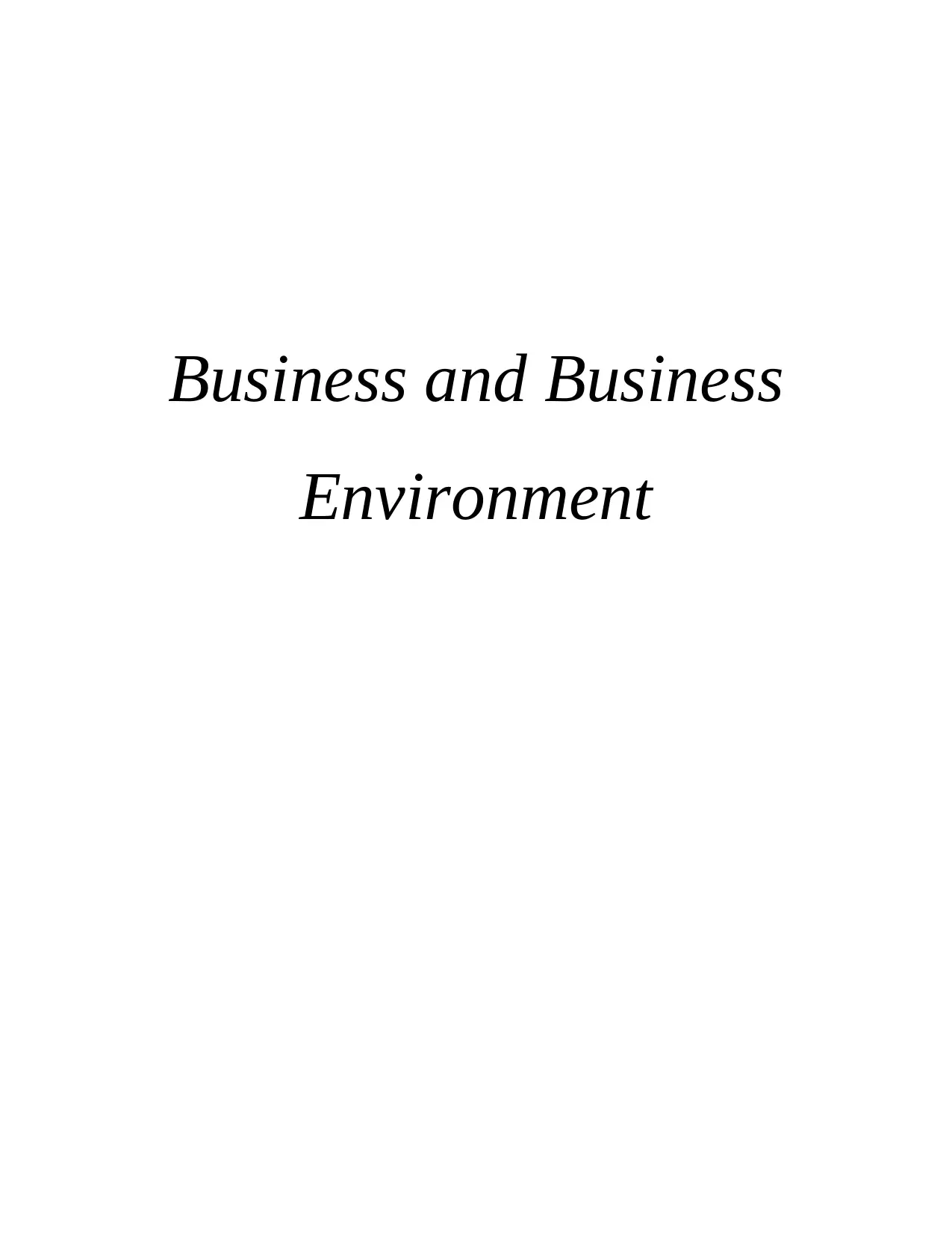
Business and Business
Environment
Environment
Paraphrase This Document
Need a fresh take? Get an instant paraphrase of this document with our AI Paraphraser
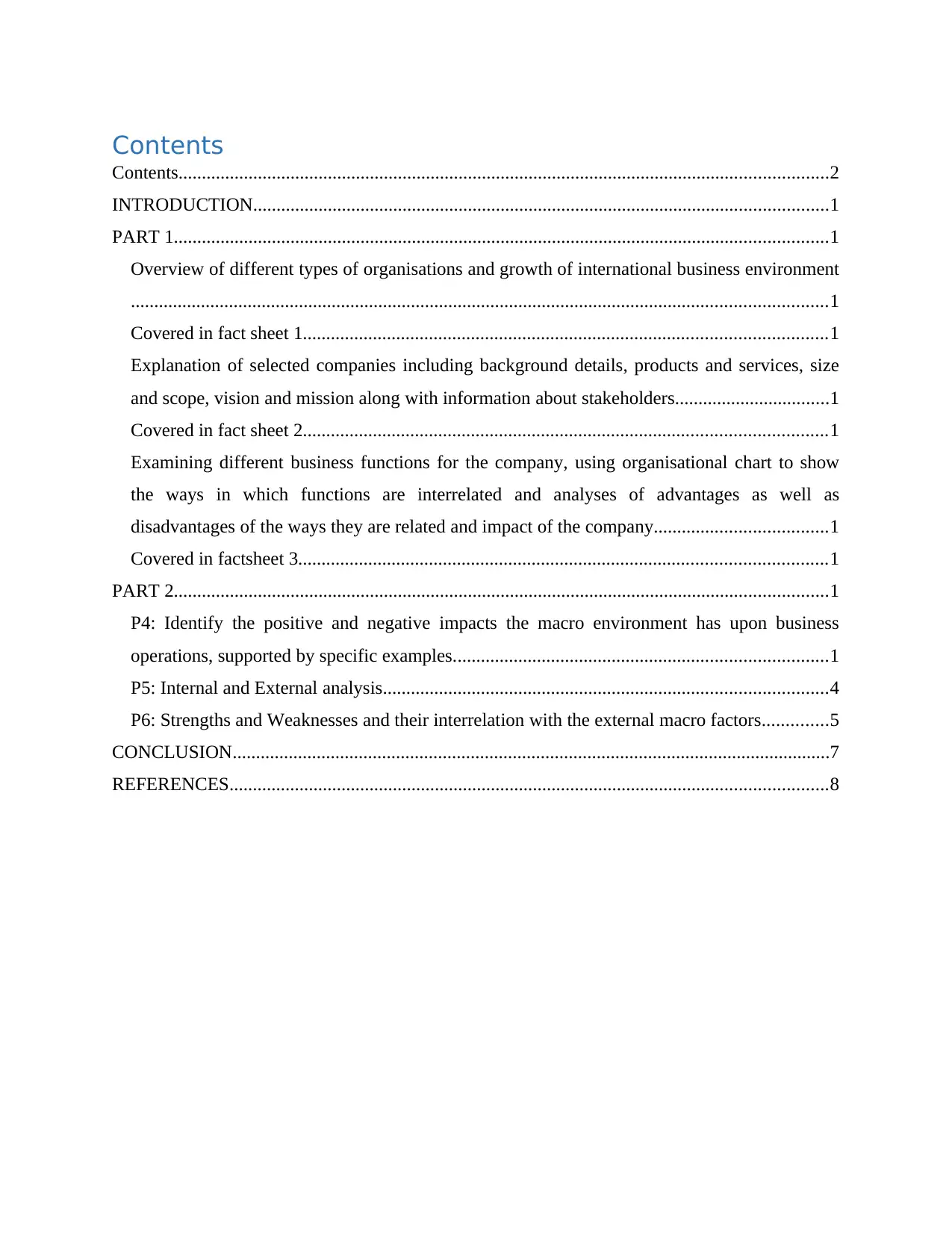
Contents
Contents...........................................................................................................................................2
INTRODUCTION...........................................................................................................................1
PART 1............................................................................................................................................1
Overview of different types of organisations and growth of international business environment
.....................................................................................................................................................1
Covered in fact sheet 1................................................................................................................1
Explanation of selected companies including background details, products and services, size
and scope, vision and mission along with information about stakeholders.................................1
Covered in fact sheet 2................................................................................................................1
Examining different business functions for the company, using organisational chart to show
the ways in which functions are interrelated and analyses of advantages as well as
disadvantages of the ways they are related and impact of the company.....................................1
Covered in factsheet 3.................................................................................................................1
PART 2............................................................................................................................................1
P4: Identify the positive and negative impacts the macro environment has upon business
operations, supported by specific examples................................................................................1
P5: Internal and External analysis...............................................................................................4
P6: Strengths and Weaknesses and their interrelation with the external macro factors..............5
CONCLUSION................................................................................................................................7
REFERENCES................................................................................................................................8
Contents...........................................................................................................................................2
INTRODUCTION...........................................................................................................................1
PART 1............................................................................................................................................1
Overview of different types of organisations and growth of international business environment
.....................................................................................................................................................1
Covered in fact sheet 1................................................................................................................1
Explanation of selected companies including background details, products and services, size
and scope, vision and mission along with information about stakeholders.................................1
Covered in fact sheet 2................................................................................................................1
Examining different business functions for the company, using organisational chart to show
the ways in which functions are interrelated and analyses of advantages as well as
disadvantages of the ways they are related and impact of the company.....................................1
Covered in factsheet 3.................................................................................................................1
PART 2............................................................................................................................................1
P4: Identify the positive and negative impacts the macro environment has upon business
operations, supported by specific examples................................................................................1
P5: Internal and External analysis...............................................................................................4
P6: Strengths and Weaknesses and their interrelation with the external macro factors..............5
CONCLUSION................................................................................................................................7
REFERENCES................................................................................................................................8

⊘ This is a preview!⊘
Do you want full access?
Subscribe today to unlock all pages.

Trusted by 1+ million students worldwide
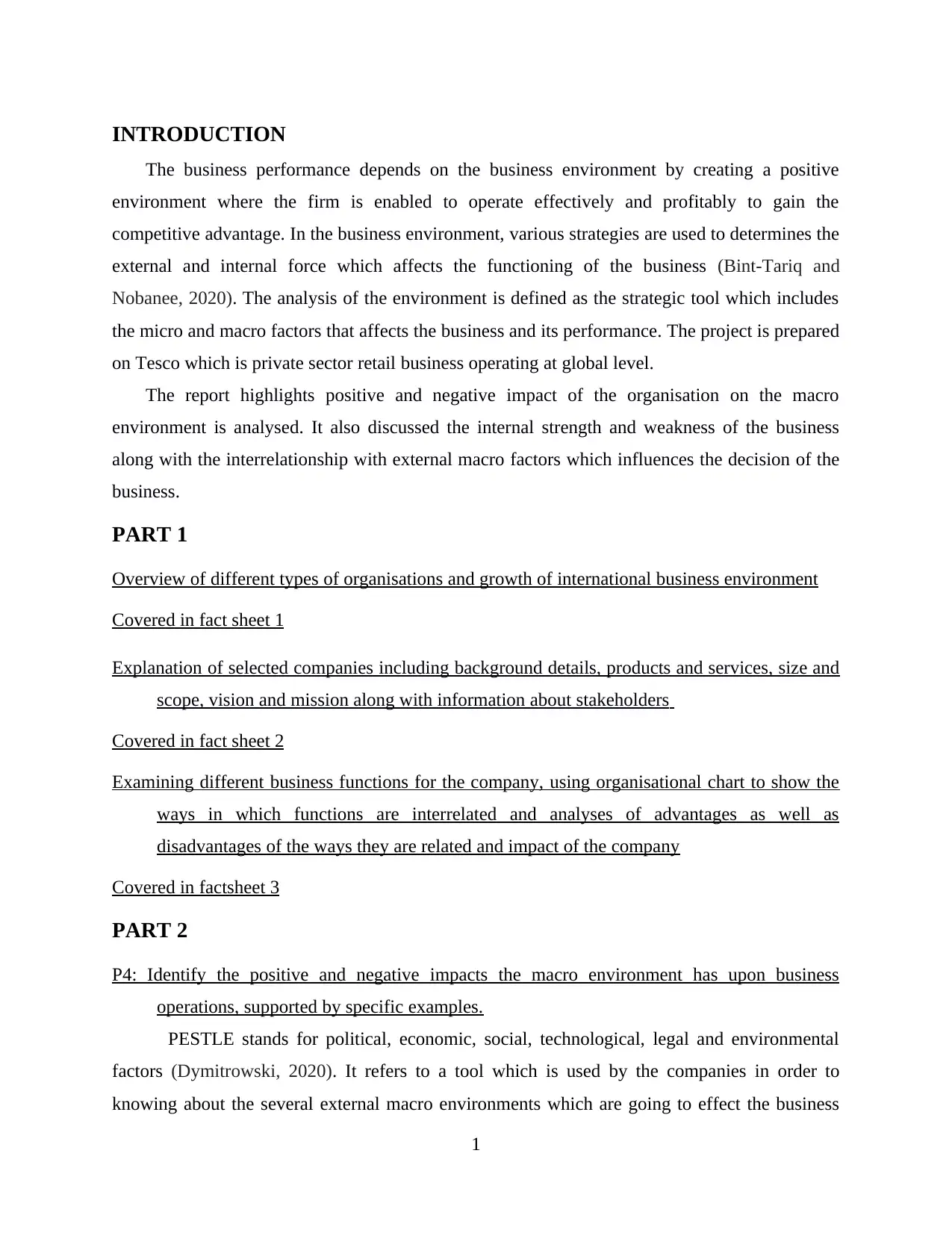
INTRODUCTION
The business performance depends on the business environment by creating a positive
environment where the firm is enabled to operate effectively and profitably to gain the
competitive advantage. In the business environment, various strategies are used to determines the
external and internal force which affects the functioning of the business (Bint-Tariq and
Nobanee, 2020). The analysis of the environment is defined as the strategic tool which includes
the micro and macro factors that affects the business and its performance. The project is prepared
on Tesco which is private sector retail business operating at global level.
The report highlights positive and negative impact of the organisation on the macro
environment is analysed. It also discussed the internal strength and weakness of the business
along with the interrelationship with external macro factors which influences the decision of the
business.
PART 1
Overview of different types of organisations and growth of international business environment
Covered in fact sheet 1
Explanation of selected companies including background details, products and services, size and
scope, vision and mission along with information about stakeholders
Covered in fact sheet 2
Examining different business functions for the company, using organisational chart to show the
ways in which functions are interrelated and analyses of advantages as well as
disadvantages of the ways they are related and impact of the company
Covered in factsheet 3
PART 2
P4: Identify the positive and negative impacts the macro environment has upon business
operations, supported by specific examples.
PESTLE stands for political, economic, social, technological, legal and environmental
factors (Dymitrowski, 2020). It refers to a tool which is used by the companies in order to
knowing about the several external macro environments which are going to effect the business
1
The business performance depends on the business environment by creating a positive
environment where the firm is enabled to operate effectively and profitably to gain the
competitive advantage. In the business environment, various strategies are used to determines the
external and internal force which affects the functioning of the business (Bint-Tariq and
Nobanee, 2020). The analysis of the environment is defined as the strategic tool which includes
the micro and macro factors that affects the business and its performance. The project is prepared
on Tesco which is private sector retail business operating at global level.
The report highlights positive and negative impact of the organisation on the macro
environment is analysed. It also discussed the internal strength and weakness of the business
along with the interrelationship with external macro factors which influences the decision of the
business.
PART 1
Overview of different types of organisations and growth of international business environment
Covered in fact sheet 1
Explanation of selected companies including background details, products and services, size and
scope, vision and mission along with information about stakeholders
Covered in fact sheet 2
Examining different business functions for the company, using organisational chart to show the
ways in which functions are interrelated and analyses of advantages as well as
disadvantages of the ways they are related and impact of the company
Covered in factsheet 3
PART 2
P4: Identify the positive and negative impacts the macro environment has upon business
operations, supported by specific examples.
PESTLE stands for political, economic, social, technological, legal and environmental
factors (Dymitrowski, 2020). It refers to a tool which is used by the companies in order to
knowing about the several external macro environments which are going to effect the business
1
Paraphrase This Document
Need a fresh take? Get an instant paraphrase of this document with our AI Paraphraser
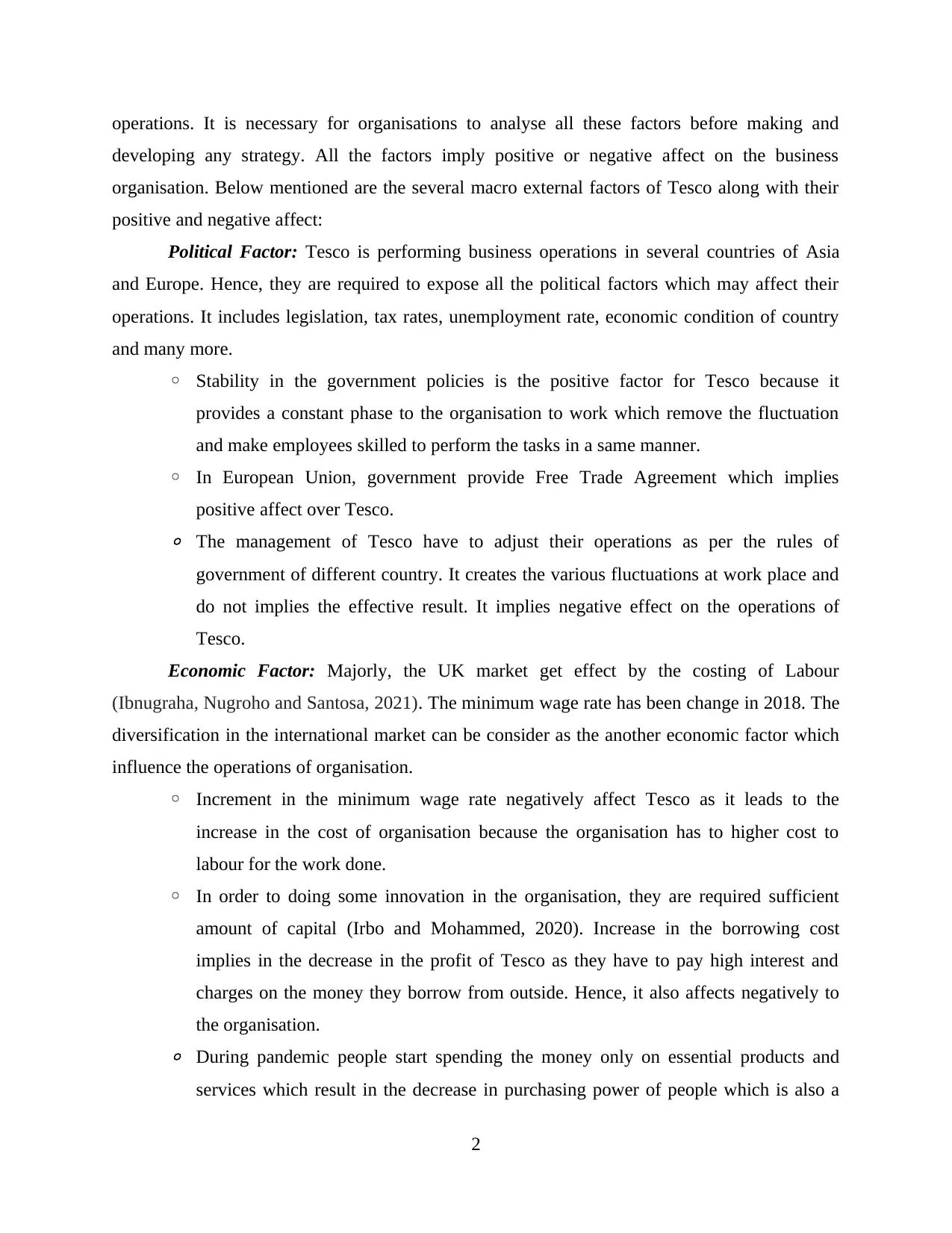
operations. It is necessary for organisations to analyse all these factors before making and
developing any strategy. All the factors imply positive or negative affect on the business
organisation. Below mentioned are the several macro external factors of Tesco along with their
positive and negative affect:
Political Factor: Tesco is performing business operations in several countries of Asia
and Europe. Hence, they are required to expose all the political factors which may affect their
operations. It includes legislation, tax rates, unemployment rate, economic condition of country
and many more.
◦ Stability in the government policies is the positive factor for Tesco because it
provides a constant phase to the organisation to work which remove the fluctuation
and make employees skilled to perform the tasks in a same manner.
◦ In European Union, government provide Free Trade Agreement which implies
positive affect over Tesco.
◦ The management of Tesco have to adjust their operations as per the rules of
government of different country. It creates the various fluctuations at work place and
do not implies the effective result. It implies negative effect on the operations of
Tesco.
Economic Factor: Majorly, the UK market get effect by the costing of Labour
(Ibnugraha, Nugroho and Santosa, 2021). The minimum wage rate has been change in 2018. The
diversification in the international market can be consider as the another economic factor which
influence the operations of organisation.
◦ Increment in the minimum wage rate negatively affect Tesco as it leads to the
increase in the cost of organisation because the organisation has to higher cost to
labour for the work done.
◦ In order to doing some innovation in the organisation, they are required sufficient
amount of capital (Irbo and Mohammed, 2020). Increase in the borrowing cost
implies in the decrease in the profit of Tesco as they have to pay high interest and
charges on the money they borrow from outside. Hence, it also affects negatively to
the organisation.
◦ During pandemic people start spending the money only on essential products and
services which result in the decrease in purchasing power of people which is also a
2
developing any strategy. All the factors imply positive or negative affect on the business
organisation. Below mentioned are the several macro external factors of Tesco along with their
positive and negative affect:
Political Factor: Tesco is performing business operations in several countries of Asia
and Europe. Hence, they are required to expose all the political factors which may affect their
operations. It includes legislation, tax rates, unemployment rate, economic condition of country
and many more.
◦ Stability in the government policies is the positive factor for Tesco because it
provides a constant phase to the organisation to work which remove the fluctuation
and make employees skilled to perform the tasks in a same manner.
◦ In European Union, government provide Free Trade Agreement which implies
positive affect over Tesco.
◦ The management of Tesco have to adjust their operations as per the rules of
government of different country. It creates the various fluctuations at work place and
do not implies the effective result. It implies negative effect on the operations of
Tesco.
Economic Factor: Majorly, the UK market get effect by the costing of Labour
(Ibnugraha, Nugroho and Santosa, 2021). The minimum wage rate has been change in 2018. The
diversification in the international market can be consider as the another economic factor which
influence the operations of organisation.
◦ Increment in the minimum wage rate negatively affect Tesco as it leads to the
increase in the cost of organisation because the organisation has to higher cost to
labour for the work done.
◦ In order to doing some innovation in the organisation, they are required sufficient
amount of capital (Irbo and Mohammed, 2020). Increase in the borrowing cost
implies in the decrease in the profit of Tesco as they have to pay high interest and
charges on the money they borrow from outside. Hence, it also affects negatively to
the organisation.
◦ During pandemic people start spending the money only on essential products and
services which result in the decrease in purchasing power of people which is also a
2
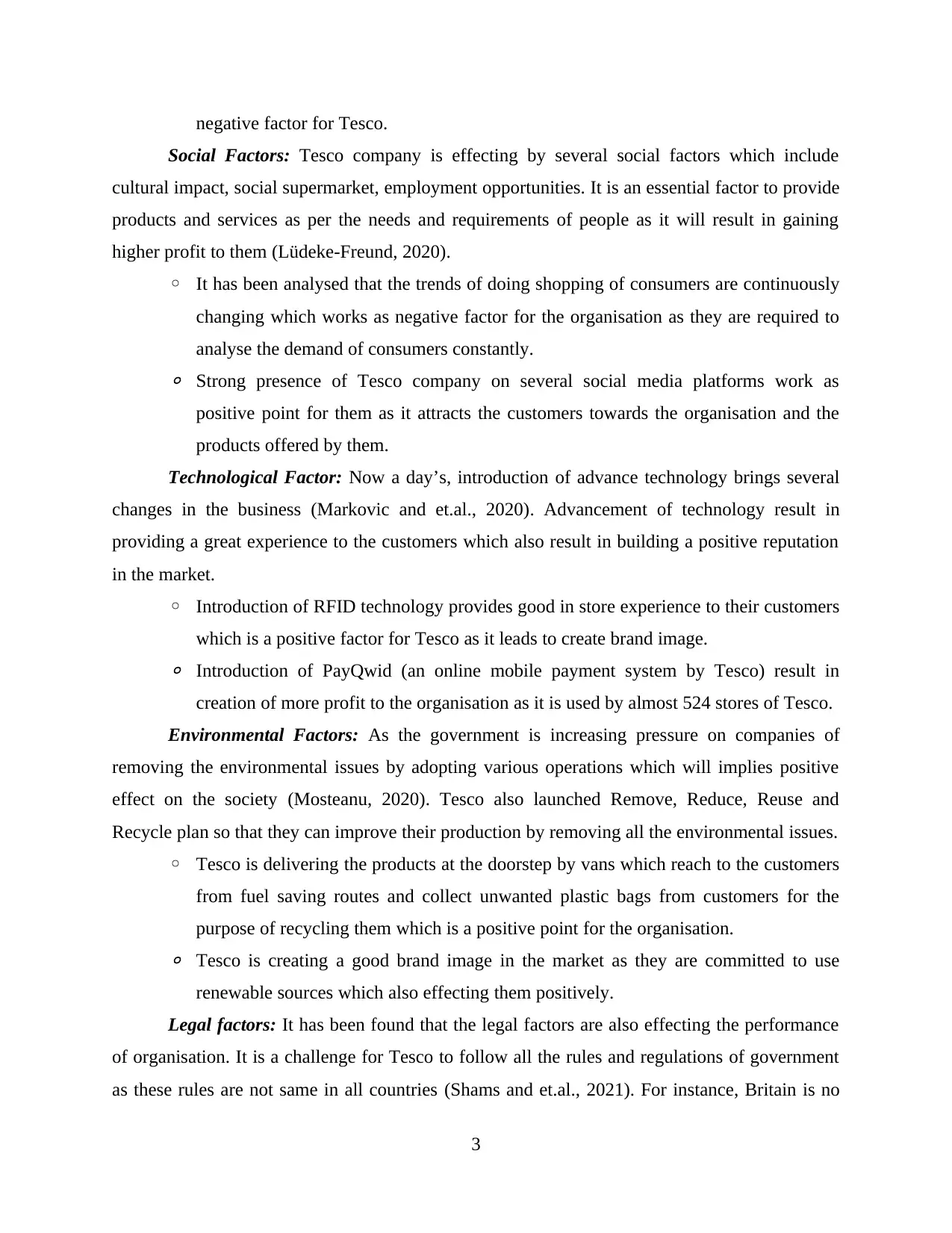
negative factor for Tesco.
Social Factors: Tesco company is effecting by several social factors which include
cultural impact, social supermarket, employment opportunities. It is an essential factor to provide
products and services as per the needs and requirements of people as it will result in gaining
higher profit to them (Lüdeke‐Freund, 2020).
◦ It has been analysed that the trends of doing shopping of consumers are continuously
changing which works as negative factor for the organisation as they are required to
analyse the demand of consumers constantly.
◦ Strong presence of Tesco company on several social media platforms work as
positive point for them as it attracts the customers towards the organisation and the
products offered by them.
Technological Factor: Now a day’s, introduction of advance technology brings several
changes in the business (Markovic and et.al., 2020). Advancement of technology result in
providing a great experience to the customers which also result in building a positive reputation
in the market.
◦ Introduction of RFID technology provides good in store experience to their customers
which is a positive factor for Tesco as it leads to create brand image.
◦ Introduction of PayQwid (an online mobile payment system by Tesco) result in
creation of more profit to the organisation as it is used by almost 524 stores of Tesco.
Environmental Factors: As the government is increasing pressure on companies of
removing the environmental issues by adopting various operations which will implies positive
effect on the society (Mosteanu, 2020). Tesco also launched Remove, Reduce, Reuse and
Recycle plan so that they can improve their production by removing all the environmental issues.
◦ Tesco is delivering the products at the doorstep by vans which reach to the customers
from fuel saving routes and collect unwanted plastic bags from customers for the
purpose of recycling them which is a positive point for the organisation.
◦ Tesco is creating a good brand image in the market as they are committed to use
renewable sources which also effecting them positively.
Legal factors: It has been found that the legal factors are also effecting the performance
of organisation. It is a challenge for Tesco to follow all the rules and regulations of government
as these rules are not same in all countries (Shams and et.al., 2021). For instance, Britain is no
3
Social Factors: Tesco company is effecting by several social factors which include
cultural impact, social supermarket, employment opportunities. It is an essential factor to provide
products and services as per the needs and requirements of people as it will result in gaining
higher profit to them (Lüdeke‐Freund, 2020).
◦ It has been analysed that the trends of doing shopping of consumers are continuously
changing which works as negative factor for the organisation as they are required to
analyse the demand of consumers constantly.
◦ Strong presence of Tesco company on several social media platforms work as
positive point for them as it attracts the customers towards the organisation and the
products offered by them.
Technological Factor: Now a day’s, introduction of advance technology brings several
changes in the business (Markovic and et.al., 2020). Advancement of technology result in
providing a great experience to the customers which also result in building a positive reputation
in the market.
◦ Introduction of RFID technology provides good in store experience to their customers
which is a positive factor for Tesco as it leads to create brand image.
◦ Introduction of PayQwid (an online mobile payment system by Tesco) result in
creation of more profit to the organisation as it is used by almost 524 stores of Tesco.
Environmental Factors: As the government is increasing pressure on companies of
removing the environmental issues by adopting various operations which will implies positive
effect on the society (Mosteanu, 2020). Tesco also launched Remove, Reduce, Reuse and
Recycle plan so that they can improve their production by removing all the environmental issues.
◦ Tesco is delivering the products at the doorstep by vans which reach to the customers
from fuel saving routes and collect unwanted plastic bags from customers for the
purpose of recycling them which is a positive point for the organisation.
◦ Tesco is creating a good brand image in the market as they are committed to use
renewable sources which also effecting them positively.
Legal factors: It has been found that the legal factors are also effecting the performance
of organisation. It is a challenge for Tesco to follow all the rules and regulations of government
as these rules are not same in all countries (Shams and et.al., 2021). For instance, Britain is no
3
⊘ This is a preview!⊘
Do you want full access?
Subscribe today to unlock all pages.

Trusted by 1+ million students worldwide
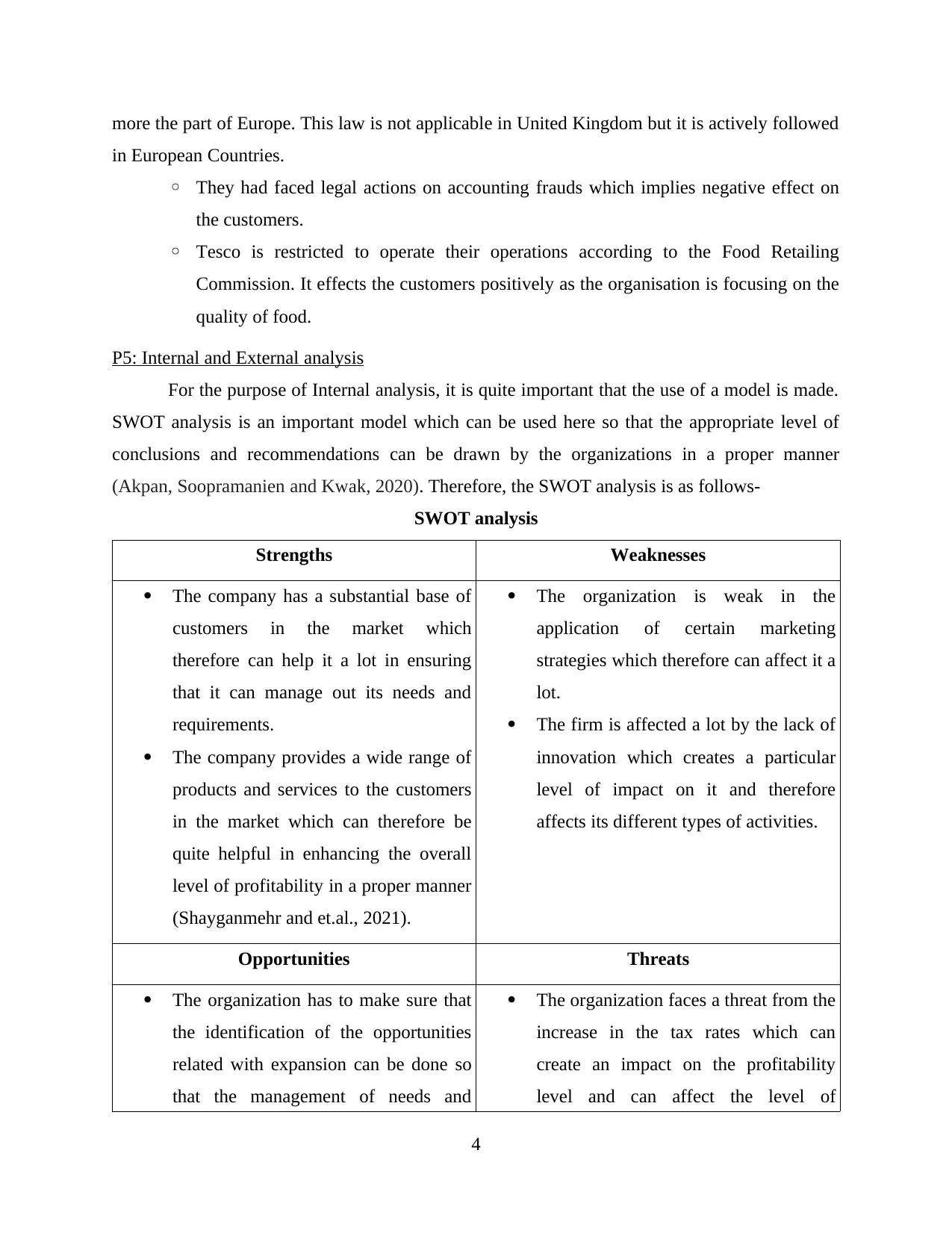
more the part of Europe. This law is not applicable in United Kingdom but it is actively followed
in European Countries.
◦ They had faced legal actions on accounting frauds which implies negative effect on
the customers.
◦ Tesco is restricted to operate their operations according to the Food Retailing
Commission. It effects the customers positively as the organisation is focusing on the
quality of food.
P5: Internal and External analysis
For the purpose of Internal analysis, it is quite important that the use of a model is made.
SWOT analysis is an important model which can be used here so that the appropriate level of
conclusions and recommendations can be drawn by the organizations in a proper manner
(Akpan, Soopramanien and Kwak, 2020). Therefore, the SWOT analysis is as follows-
SWOT analysis
Strengths Weaknesses
The company has a substantial base of
customers in the market which
therefore can help it a lot in ensuring
that it can manage out its needs and
requirements.
The company provides a wide range of
products and services to the customers
in the market which can therefore be
quite helpful in enhancing the overall
level of profitability in a proper manner
(Shayganmehr and et.al., 2021).
The organization is weak in the
application of certain marketing
strategies which therefore can affect it a
lot.
The firm is affected a lot by the lack of
innovation which creates a particular
level of impact on it and therefore
affects its different types of activities.
Opportunities Threats
The organization has to make sure that
the identification of the opportunities
related with expansion can be done so
that the management of needs and
The organization faces a threat from the
increase in the tax rates which can
create an impact on the profitability
level and can affect the level of
4
in European Countries.
◦ They had faced legal actions on accounting frauds which implies negative effect on
the customers.
◦ Tesco is restricted to operate their operations according to the Food Retailing
Commission. It effects the customers positively as the organisation is focusing on the
quality of food.
P5: Internal and External analysis
For the purpose of Internal analysis, it is quite important that the use of a model is made.
SWOT analysis is an important model which can be used here so that the appropriate level of
conclusions and recommendations can be drawn by the organizations in a proper manner
(Akpan, Soopramanien and Kwak, 2020). Therefore, the SWOT analysis is as follows-
SWOT analysis
Strengths Weaknesses
The company has a substantial base of
customers in the market which
therefore can help it a lot in ensuring
that it can manage out its needs and
requirements.
The company provides a wide range of
products and services to the customers
in the market which can therefore be
quite helpful in enhancing the overall
level of profitability in a proper manner
(Shayganmehr and et.al., 2021).
The organization is weak in the
application of certain marketing
strategies which therefore can affect it a
lot.
The firm is affected a lot by the lack of
innovation which creates a particular
level of impact on it and therefore
affects its different types of activities.
Opportunities Threats
The organization has to make sure that
the identification of the opportunities
related with expansion can be done so
that the management of needs and
The organization faces a threat from the
increase in the tax rates which can
create an impact on the profitability
level and can affect the level of
4
Paraphrase This Document
Need a fresh take? Get an instant paraphrase of this document with our AI Paraphraser
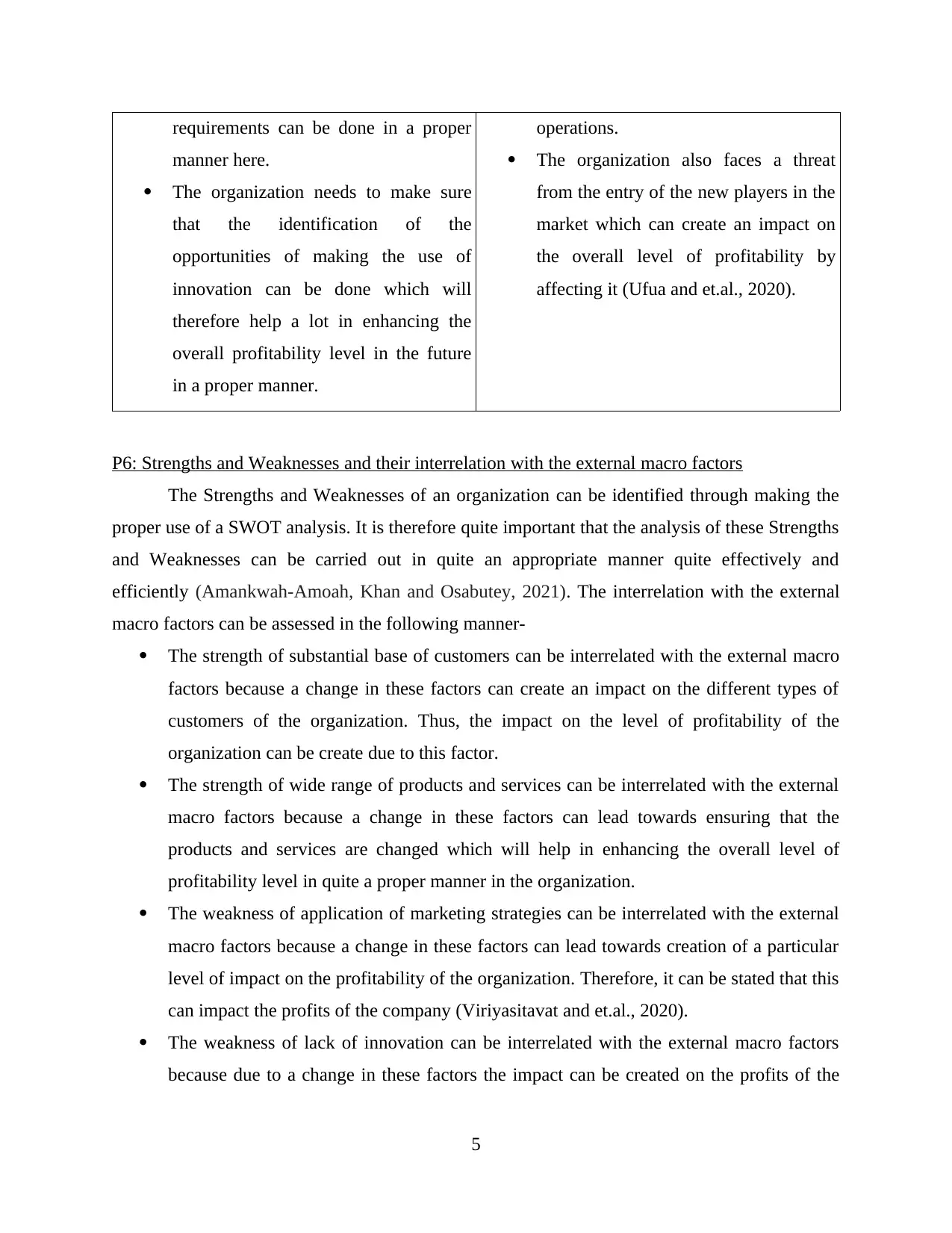
requirements can be done in a proper
manner here.
The organization needs to make sure
that the identification of the
opportunities of making the use of
innovation can be done which will
therefore help a lot in enhancing the
overall profitability level in the future
in a proper manner.
operations.
The organization also faces a threat
from the entry of the new players in the
market which can create an impact on
the overall level of profitability by
affecting it (Ufua and et.al., 2020).
P6: Strengths and Weaknesses and their interrelation with the external macro factors
The Strengths and Weaknesses of an organization can be identified through making the
proper use of a SWOT analysis. It is therefore quite important that the analysis of these Strengths
and Weaknesses can be carried out in quite an appropriate manner quite effectively and
efficiently (Amankwah-Amoah, Khan and Osabutey, 2021). The interrelation with the external
macro factors can be assessed in the following manner-
The strength of substantial base of customers can be interrelated with the external macro
factors because a change in these factors can create an impact on the different types of
customers of the organization. Thus, the impact on the level of profitability of the
organization can be create due to this factor.
The strength of wide range of products and services can be interrelated with the external
macro factors because a change in these factors can lead towards ensuring that the
products and services are changed which will help in enhancing the overall level of
profitability level in quite a proper manner in the organization.
The weakness of application of marketing strategies can be interrelated with the external
macro factors because a change in these factors can lead towards creation of a particular
level of impact on the profitability of the organization. Therefore, it can be stated that this
can impact the profits of the company (Viriyasitavat and et.al., 2020).
The weakness of lack of innovation can be interrelated with the external macro factors
because due to a change in these factors the impact can be created on the profits of the
5
manner here.
The organization needs to make sure
that the identification of the
opportunities of making the use of
innovation can be done which will
therefore help a lot in enhancing the
overall profitability level in the future
in a proper manner.
operations.
The organization also faces a threat
from the entry of the new players in the
market which can create an impact on
the overall level of profitability by
affecting it (Ufua and et.al., 2020).
P6: Strengths and Weaknesses and their interrelation with the external macro factors
The Strengths and Weaknesses of an organization can be identified through making the
proper use of a SWOT analysis. It is therefore quite important that the analysis of these Strengths
and Weaknesses can be carried out in quite an appropriate manner quite effectively and
efficiently (Amankwah-Amoah, Khan and Osabutey, 2021). The interrelation with the external
macro factors can be assessed in the following manner-
The strength of substantial base of customers can be interrelated with the external macro
factors because a change in these factors can create an impact on the different types of
customers of the organization. Thus, the impact on the level of profitability of the
organization can be create due to this factor.
The strength of wide range of products and services can be interrelated with the external
macro factors because a change in these factors can lead towards ensuring that the
products and services are changed which will help in enhancing the overall level of
profitability level in quite a proper manner in the organization.
The weakness of application of marketing strategies can be interrelated with the external
macro factors because a change in these factors can lead towards creation of a particular
level of impact on the profitability of the organization. Therefore, it can be stated that this
can impact the profits of the company (Viriyasitavat and et.al., 2020).
The weakness of lack of innovation can be interrelated with the external macro factors
because due to a change in these factors the impact can be created on the profits of the
5
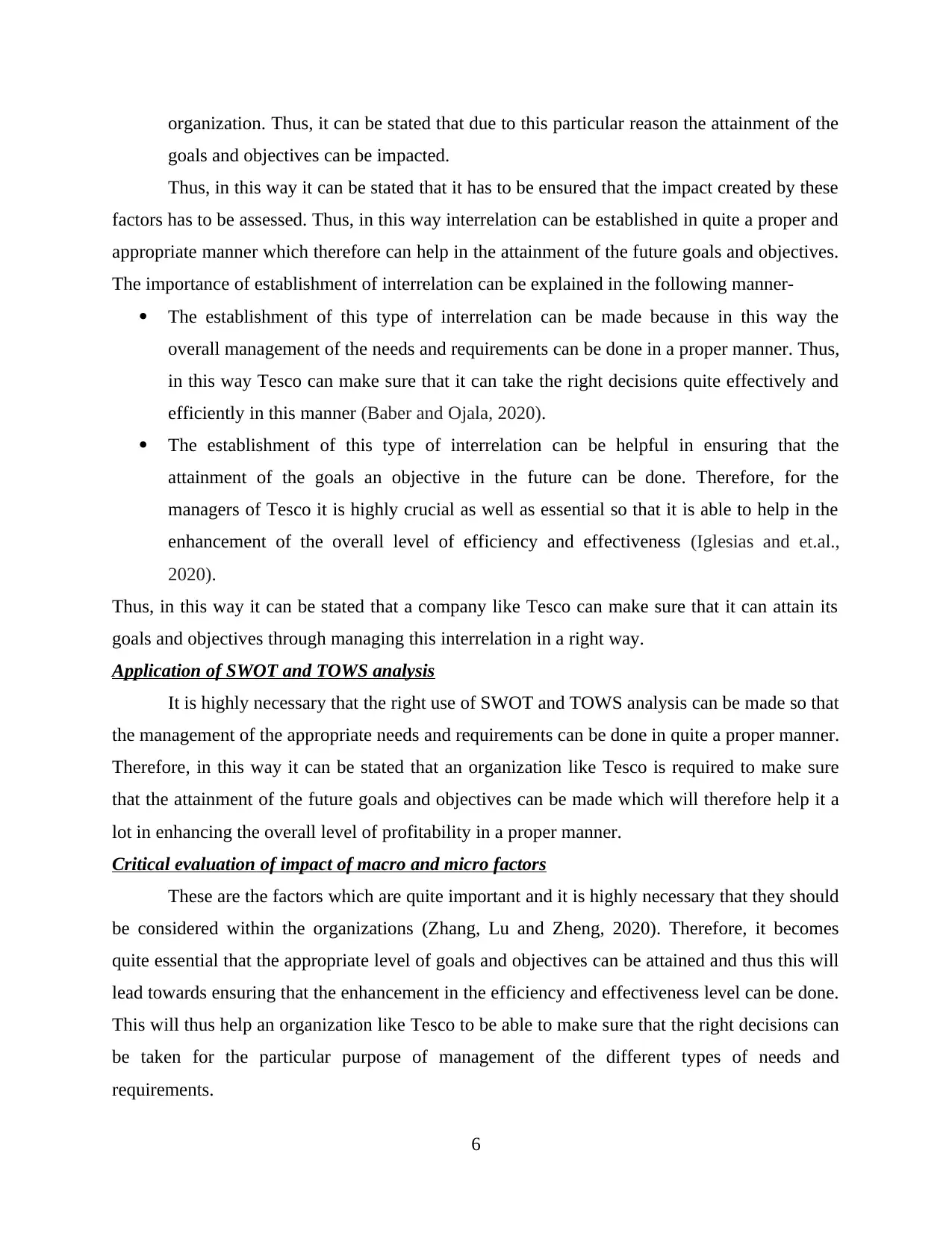
organization. Thus, it can be stated that due to this particular reason the attainment of the
goals and objectives can be impacted.
Thus, in this way it can be stated that it has to be ensured that the impact created by these
factors has to be assessed. Thus, in this way interrelation can be established in quite a proper and
appropriate manner which therefore can help in the attainment of the future goals and objectives.
The importance of establishment of interrelation can be explained in the following manner-
The establishment of this type of interrelation can be made because in this way the
overall management of the needs and requirements can be done in a proper manner. Thus,
in this way Tesco can make sure that it can take the right decisions quite effectively and
efficiently in this manner (Baber and Ojala, 2020).
The establishment of this type of interrelation can be helpful in ensuring that the
attainment of the goals an objective in the future can be done. Therefore, for the
managers of Tesco it is highly crucial as well as essential so that it is able to help in the
enhancement of the overall level of efficiency and effectiveness (Iglesias and et.al.,
2020).
Thus, in this way it can be stated that a company like Tesco can make sure that it can attain its
goals and objectives through managing this interrelation in a right way.
Application of SWOT and TOWS analysis
It is highly necessary that the right use of SWOT and TOWS analysis can be made so that
the management of the appropriate needs and requirements can be done in quite a proper manner.
Therefore, in this way it can be stated that an organization like Tesco is required to make sure
that the attainment of the future goals and objectives can be made which will therefore help it a
lot in enhancing the overall level of profitability in a proper manner.
Critical evaluation of impact of macro and micro factors
These are the factors which are quite important and it is highly necessary that they should
be considered within the organizations (Zhang, Lu and Zheng, 2020). Therefore, it becomes
quite essential that the appropriate level of goals and objectives can be attained and thus this will
lead towards ensuring that the enhancement in the efficiency and effectiveness level can be done.
This will thus help an organization like Tesco to be able to make sure that the right decisions can
be taken for the particular purpose of management of the different types of needs and
requirements.
6
goals and objectives can be impacted.
Thus, in this way it can be stated that it has to be ensured that the impact created by these
factors has to be assessed. Thus, in this way interrelation can be established in quite a proper and
appropriate manner which therefore can help in the attainment of the future goals and objectives.
The importance of establishment of interrelation can be explained in the following manner-
The establishment of this type of interrelation can be made because in this way the
overall management of the needs and requirements can be done in a proper manner. Thus,
in this way Tesco can make sure that it can take the right decisions quite effectively and
efficiently in this manner (Baber and Ojala, 2020).
The establishment of this type of interrelation can be helpful in ensuring that the
attainment of the goals an objective in the future can be done. Therefore, for the
managers of Tesco it is highly crucial as well as essential so that it is able to help in the
enhancement of the overall level of efficiency and effectiveness (Iglesias and et.al.,
2020).
Thus, in this way it can be stated that a company like Tesco can make sure that it can attain its
goals and objectives through managing this interrelation in a right way.
Application of SWOT and TOWS analysis
It is highly necessary that the right use of SWOT and TOWS analysis can be made so that
the management of the appropriate needs and requirements can be done in quite a proper manner.
Therefore, in this way it can be stated that an organization like Tesco is required to make sure
that the attainment of the future goals and objectives can be made which will therefore help it a
lot in enhancing the overall level of profitability in a proper manner.
Critical evaluation of impact of macro and micro factors
These are the factors which are quite important and it is highly necessary that they should
be considered within the organizations (Zhang, Lu and Zheng, 2020). Therefore, it becomes
quite essential that the appropriate level of goals and objectives can be attained and thus this will
lead towards ensuring that the enhancement in the efficiency and effectiveness level can be done.
This will thus help an organization like Tesco to be able to make sure that the right decisions can
be taken for the particular purpose of management of the different types of needs and
requirements.
6
⊘ This is a preview!⊘
Do you want full access?
Subscribe today to unlock all pages.

Trusted by 1+ million students worldwide
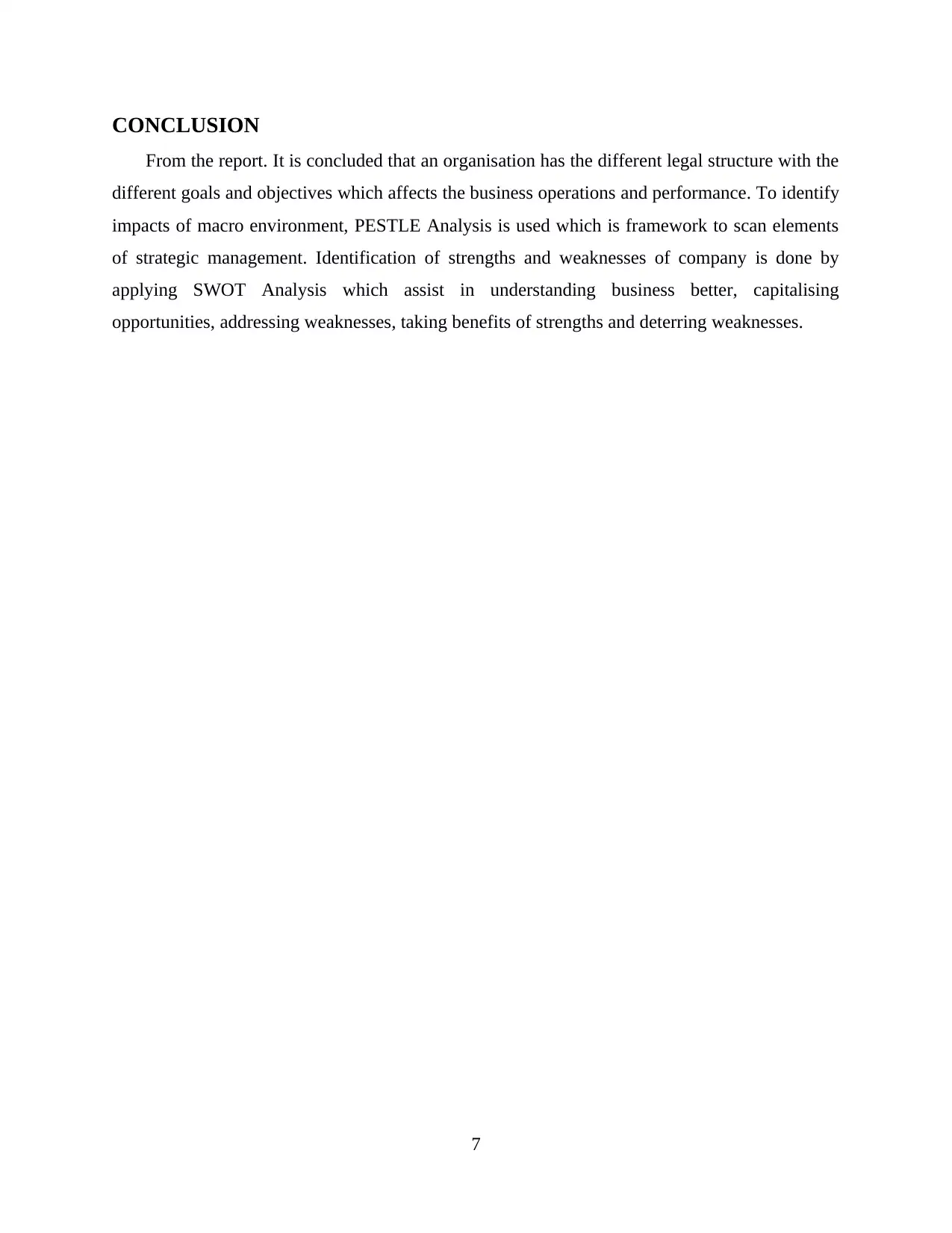
CONCLUSION
From the report. It is concluded that an organisation has the different legal structure with the
different goals and objectives which affects the business operations and performance. To identify
impacts of macro environment, PESTLE Analysis is used which is framework to scan elements
of strategic management. Identification of strengths and weaknesses of company is done by
applying SWOT Analysis which assist in understanding business better, capitalising
opportunities, addressing weaknesses, taking benefits of strengths and deterring weaknesses.
7
From the report. It is concluded that an organisation has the different legal structure with the
different goals and objectives which affects the business operations and performance. To identify
impacts of macro environment, PESTLE Analysis is used which is framework to scan elements
of strategic management. Identification of strengths and weaknesses of company is done by
applying SWOT Analysis which assist in understanding business better, capitalising
opportunities, addressing weaknesses, taking benefits of strengths and deterring weaknesses.
7
Paraphrase This Document
Need a fresh take? Get an instant paraphrase of this document with our AI Paraphraser
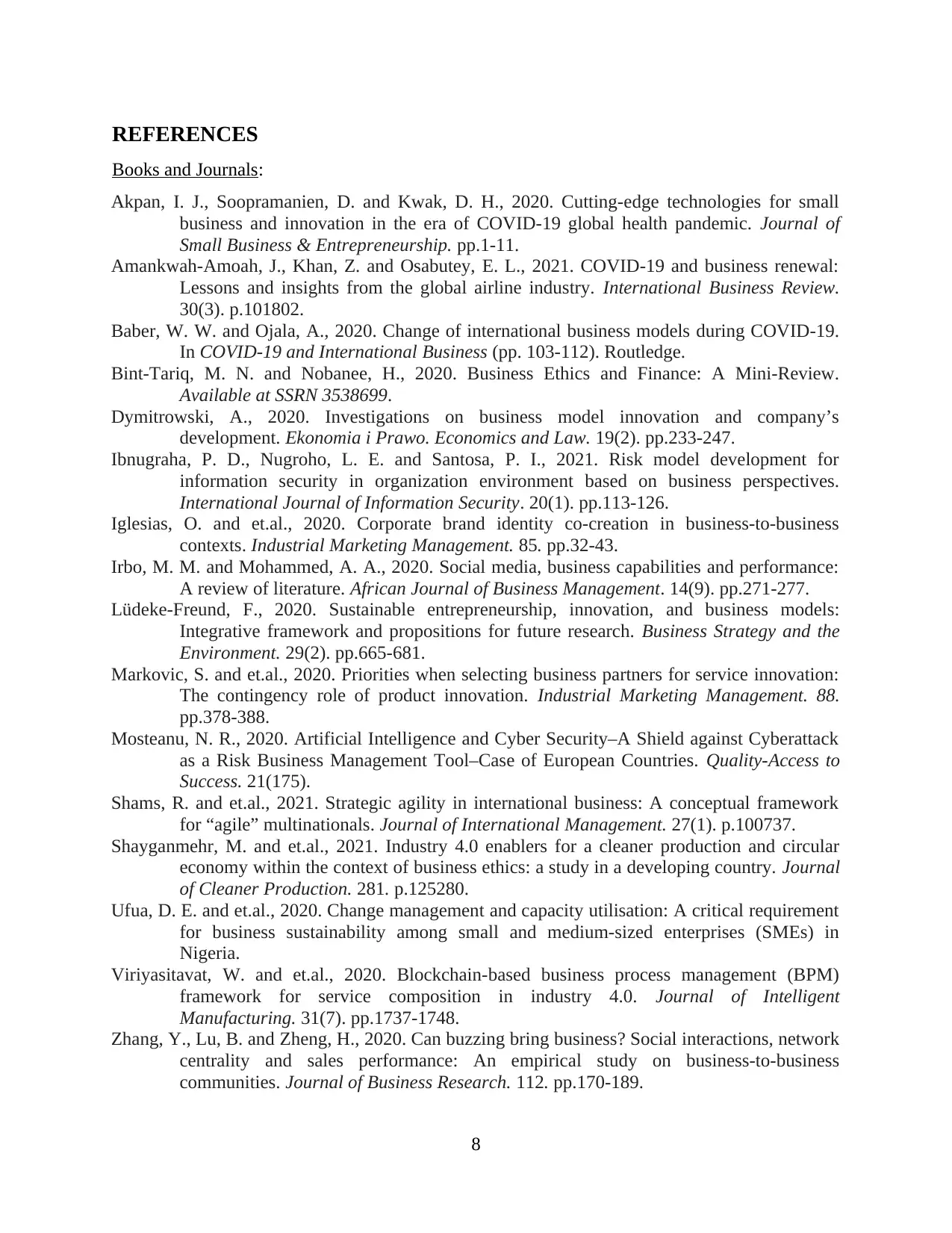
REFERENCES
Books and Journals:
Akpan, I. J., Soopramanien, D. and Kwak, D. H., 2020. Cutting-edge technologies for small
business and innovation in the era of COVID-19 global health pandemic. Journal of
Small Business & Entrepreneurship. pp.1-11.
Amankwah-Amoah, J., Khan, Z. and Osabutey, E. L., 2021. COVID-19 and business renewal:
Lessons and insights from the global airline industry. International Business Review.
30(3). p.101802.
Baber, W. W. and Ojala, A., 2020. Change of international business models during COVID-19.
In COVID-19 and International Business (pp. 103-112). Routledge.
Bint-Tariq, M. N. and Nobanee, H., 2020. Business Ethics and Finance: A Mini-Review.
Available at SSRN 3538699.
Dymitrowski, A., 2020. Investigations on business model innovation and company’s
development. Ekonomia i Prawo. Economics and Law. 19(2). pp.233-247.
Ibnugraha, P. D., Nugroho, L. E. and Santosa, P. I., 2021. Risk model development for
information security in organization environment based on business perspectives.
International Journal of Information Security. 20(1). pp.113-126.
Iglesias, O. and et.al., 2020. Corporate brand identity co-creation in business-to-business
contexts. Industrial Marketing Management. 85. pp.32-43.
Irbo, M. M. and Mohammed, A. A., 2020. Social media, business capabilities and performance:
A review of literature. African Journal of Business Management. 14(9). pp.271-277.
Lüdeke‐Freund, F., 2020. Sustainable entrepreneurship, innovation, and business models:
Integrative framework and propositions for future research. Business Strategy and the
Environment. 29(2). pp.665-681.
Markovic, S. and et.al., 2020. Priorities when selecting business partners for service innovation:
The contingency role of product innovation. Industrial Marketing Management. 88.
pp.378-388.
Mosteanu, N. R., 2020. Artificial Intelligence and Cyber Security–A Shield against Cyberattack
as a Risk Business Management Tool–Case of European Countries. Quality-Access to
Success. 21(175).
Shams, R. and et.al., 2021. Strategic agility in international business: A conceptual framework
for “agile” multinationals. Journal of International Management. 27(1). p.100737.
Shayganmehr, M. and et.al., 2021. Industry 4.0 enablers for a cleaner production and circular
economy within the context of business ethics: a study in a developing country. Journal
of Cleaner Production. 281. p.125280.
Ufua, D. E. and et.al., 2020. Change management and capacity utilisation: A critical requirement
for business sustainability among small and medium-sized enterprises (SMEs) in
Nigeria.
Viriyasitavat, W. and et.al., 2020. Blockchain-based business process management (BPM)
framework for service composition in industry 4.0. Journal of Intelligent
Manufacturing. 31(7). pp.1737-1748.
Zhang, Y., Lu, B. and Zheng, H., 2020. Can buzzing bring business? Social interactions, network
centrality and sales performance: An empirical study on business-to-business
communities. Journal of Business Research. 112. pp.170-189.
8
Books and Journals:
Akpan, I. J., Soopramanien, D. and Kwak, D. H., 2020. Cutting-edge technologies for small
business and innovation in the era of COVID-19 global health pandemic. Journal of
Small Business & Entrepreneurship. pp.1-11.
Amankwah-Amoah, J., Khan, Z. and Osabutey, E. L., 2021. COVID-19 and business renewal:
Lessons and insights from the global airline industry. International Business Review.
30(3). p.101802.
Baber, W. W. and Ojala, A., 2020. Change of international business models during COVID-19.
In COVID-19 and International Business (pp. 103-112). Routledge.
Bint-Tariq, M. N. and Nobanee, H., 2020. Business Ethics and Finance: A Mini-Review.
Available at SSRN 3538699.
Dymitrowski, A., 2020. Investigations on business model innovation and company’s
development. Ekonomia i Prawo. Economics and Law. 19(2). pp.233-247.
Ibnugraha, P. D., Nugroho, L. E. and Santosa, P. I., 2021. Risk model development for
information security in organization environment based on business perspectives.
International Journal of Information Security. 20(1). pp.113-126.
Iglesias, O. and et.al., 2020. Corporate brand identity co-creation in business-to-business
contexts. Industrial Marketing Management. 85. pp.32-43.
Irbo, M. M. and Mohammed, A. A., 2020. Social media, business capabilities and performance:
A review of literature. African Journal of Business Management. 14(9). pp.271-277.
Lüdeke‐Freund, F., 2020. Sustainable entrepreneurship, innovation, and business models:
Integrative framework and propositions for future research. Business Strategy and the
Environment. 29(2). pp.665-681.
Markovic, S. and et.al., 2020. Priorities when selecting business partners for service innovation:
The contingency role of product innovation. Industrial Marketing Management. 88.
pp.378-388.
Mosteanu, N. R., 2020. Artificial Intelligence and Cyber Security–A Shield against Cyberattack
as a Risk Business Management Tool–Case of European Countries. Quality-Access to
Success. 21(175).
Shams, R. and et.al., 2021. Strategic agility in international business: A conceptual framework
for “agile” multinationals. Journal of International Management. 27(1). p.100737.
Shayganmehr, M. and et.al., 2021. Industry 4.0 enablers for a cleaner production and circular
economy within the context of business ethics: a study in a developing country. Journal
of Cleaner Production. 281. p.125280.
Ufua, D. E. and et.al., 2020. Change management and capacity utilisation: A critical requirement
for business sustainability among small and medium-sized enterprises (SMEs) in
Nigeria.
Viriyasitavat, W. and et.al., 2020. Blockchain-based business process management (BPM)
framework for service composition in industry 4.0. Journal of Intelligent
Manufacturing. 31(7). pp.1737-1748.
Zhang, Y., Lu, B. and Zheng, H., 2020. Can buzzing bring business? Social interactions, network
centrality and sales performance: An empirical study on business-to-business
communities. Journal of Business Research. 112. pp.170-189.
8
1 out of 11
Related Documents
Your All-in-One AI-Powered Toolkit for Academic Success.
+13062052269
info@desklib.com
Available 24*7 on WhatsApp / Email
![[object Object]](/_next/static/media/star-bottom.7253800d.svg)
Unlock your academic potential
Copyright © 2020–2025 A2Z Services. All Rights Reserved. Developed and managed by ZUCOL.





